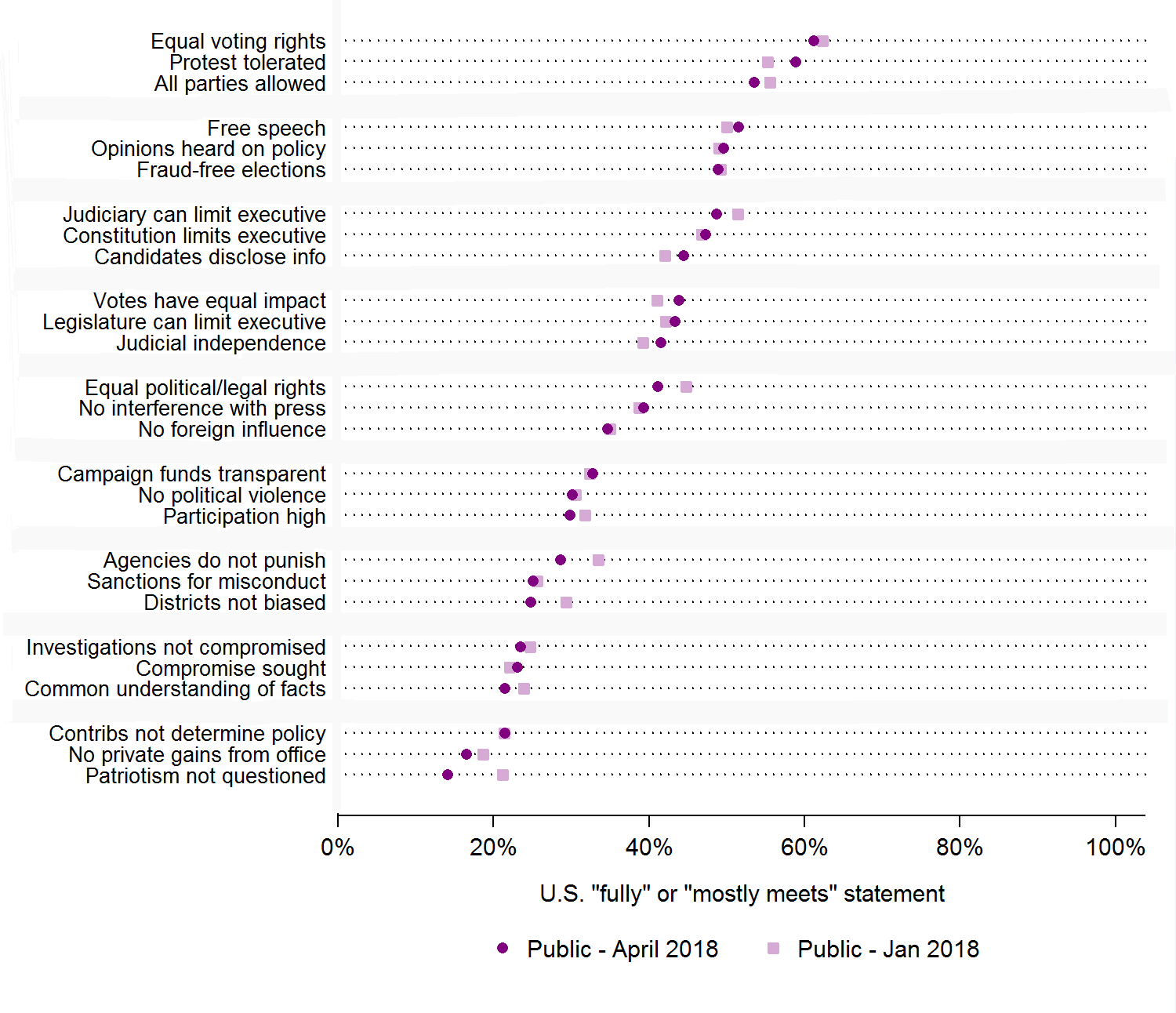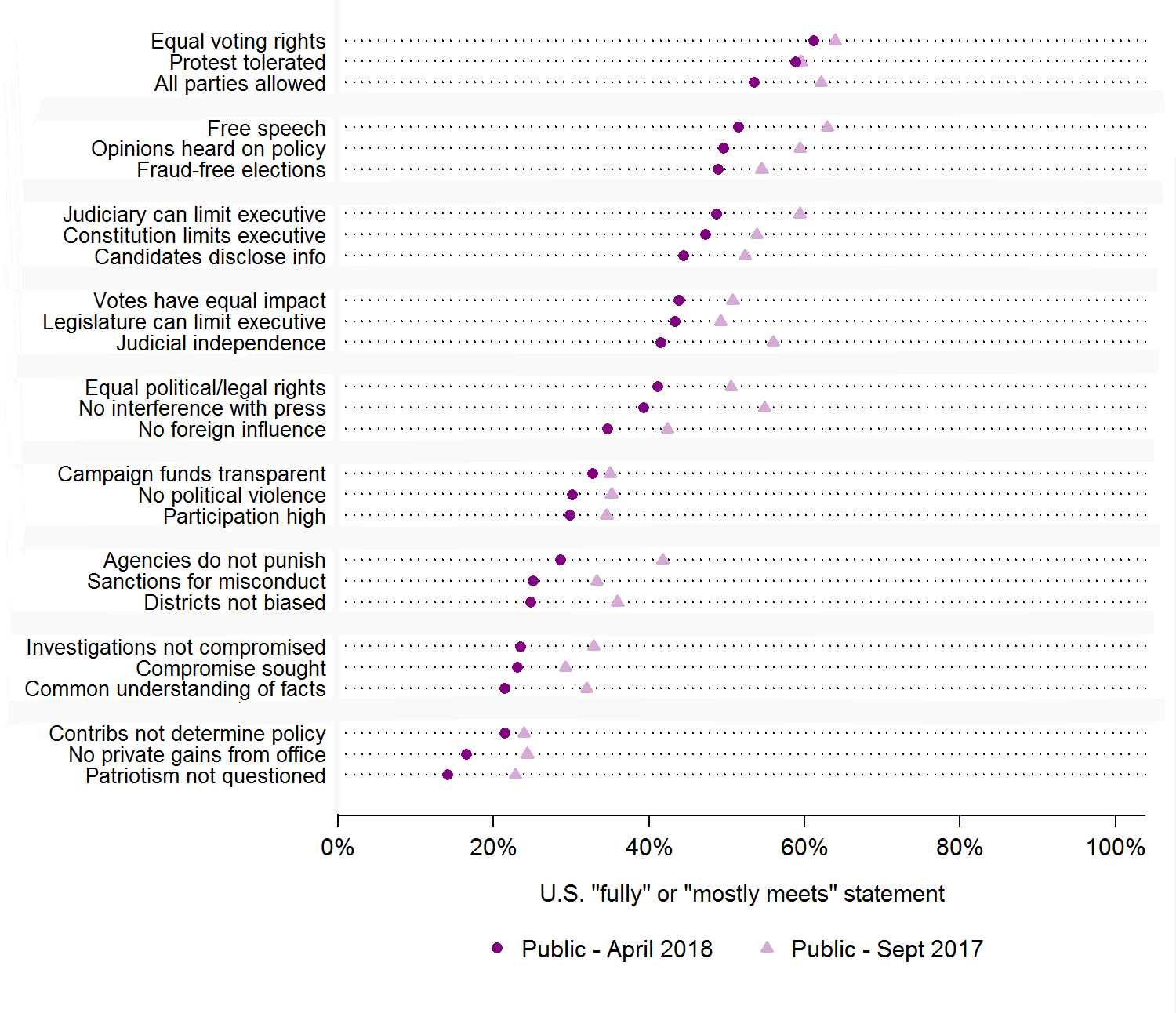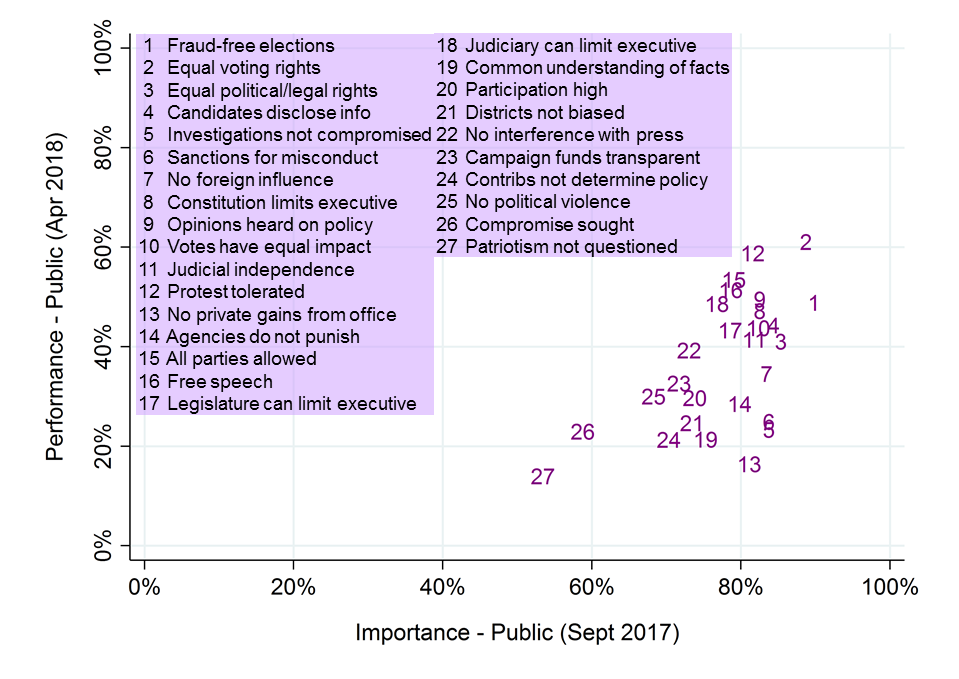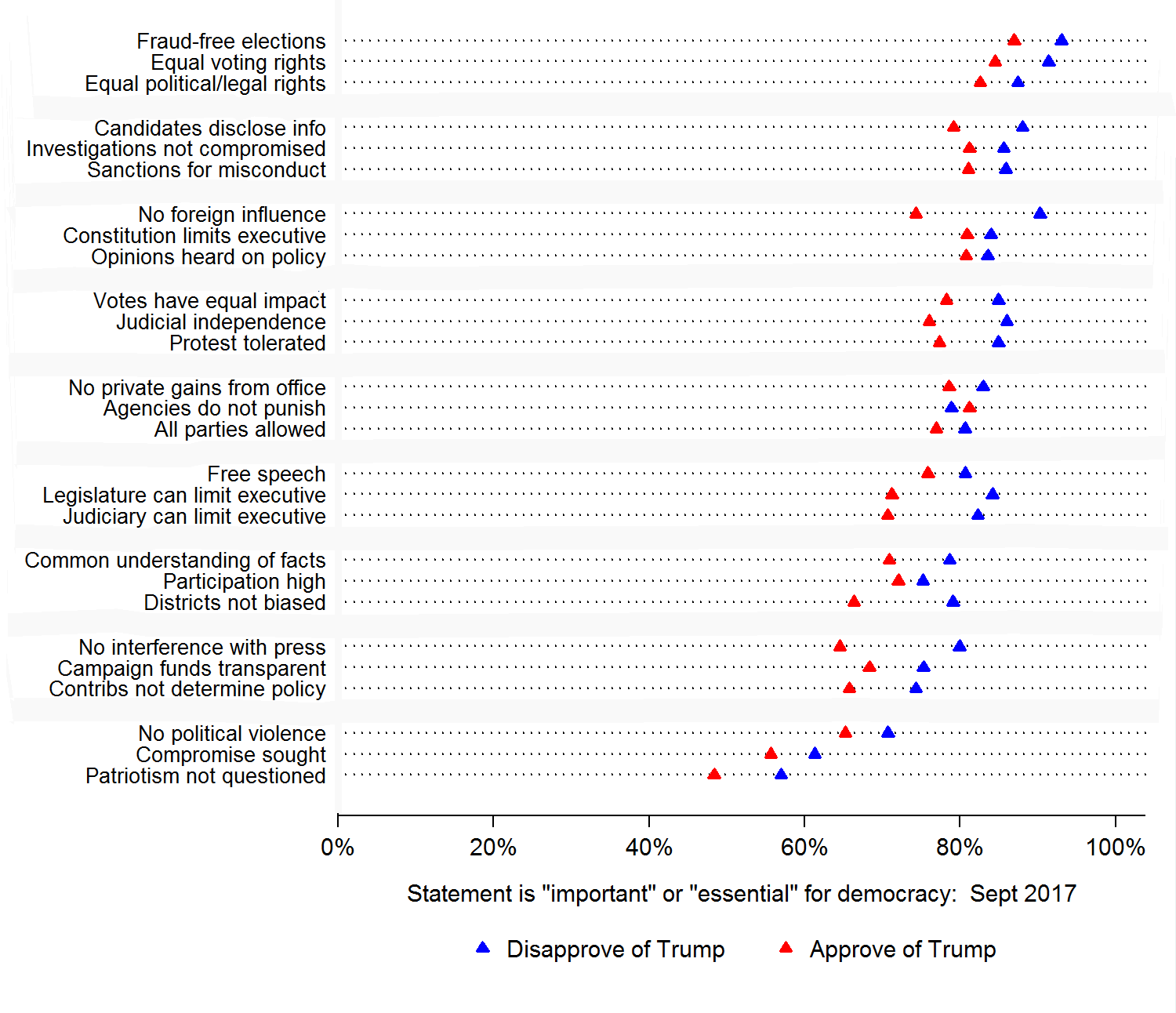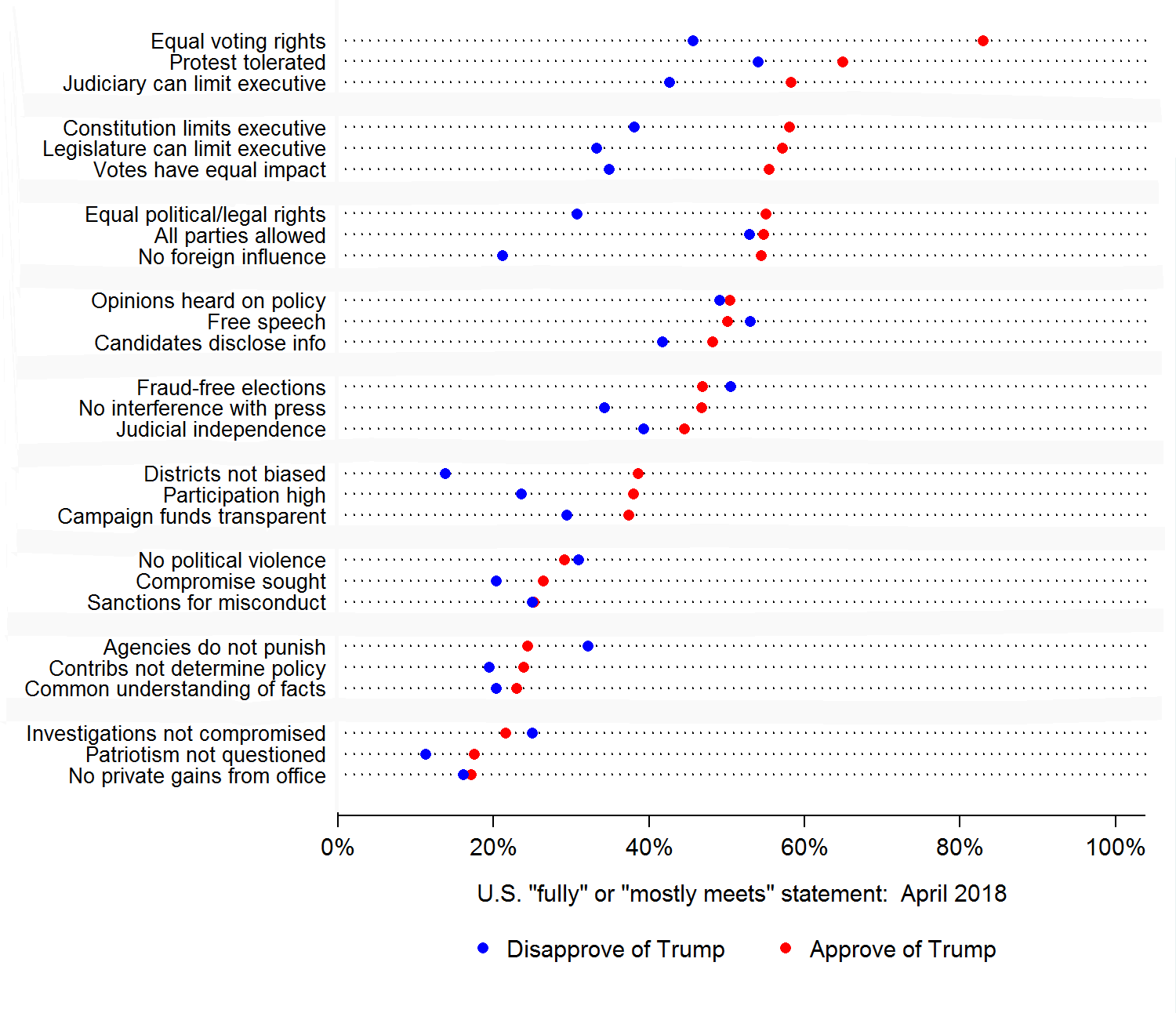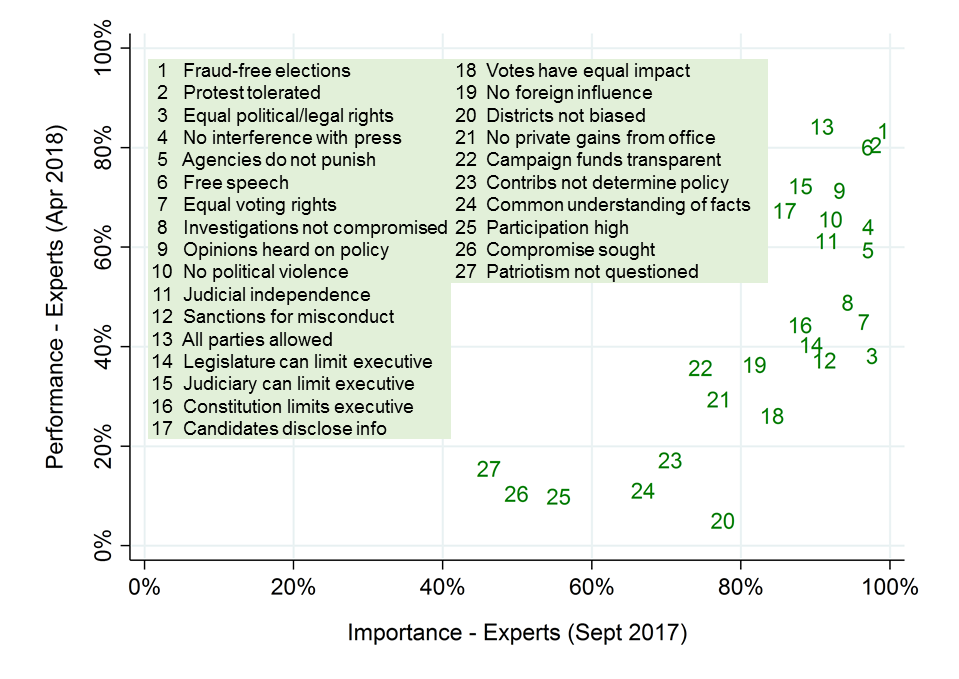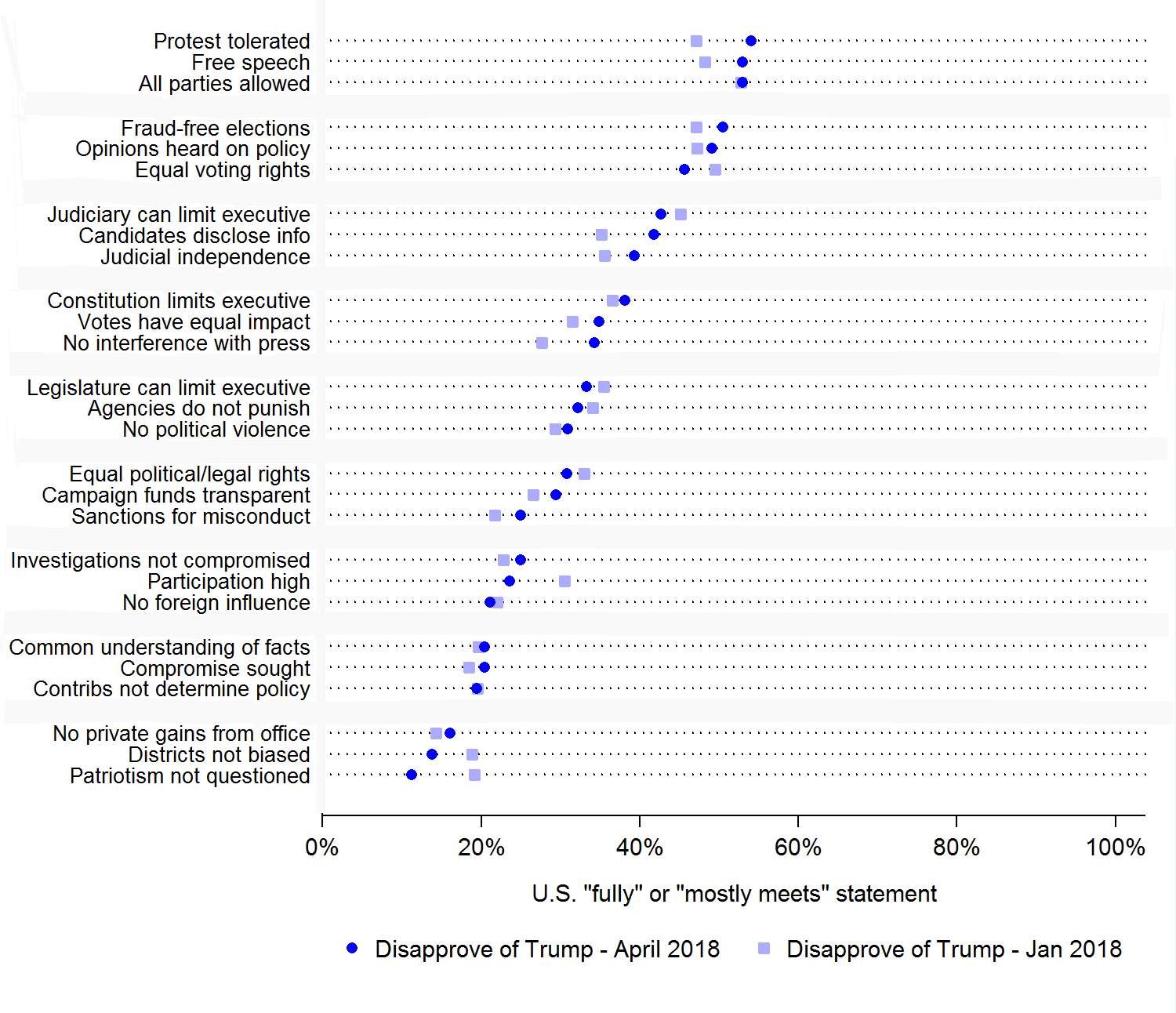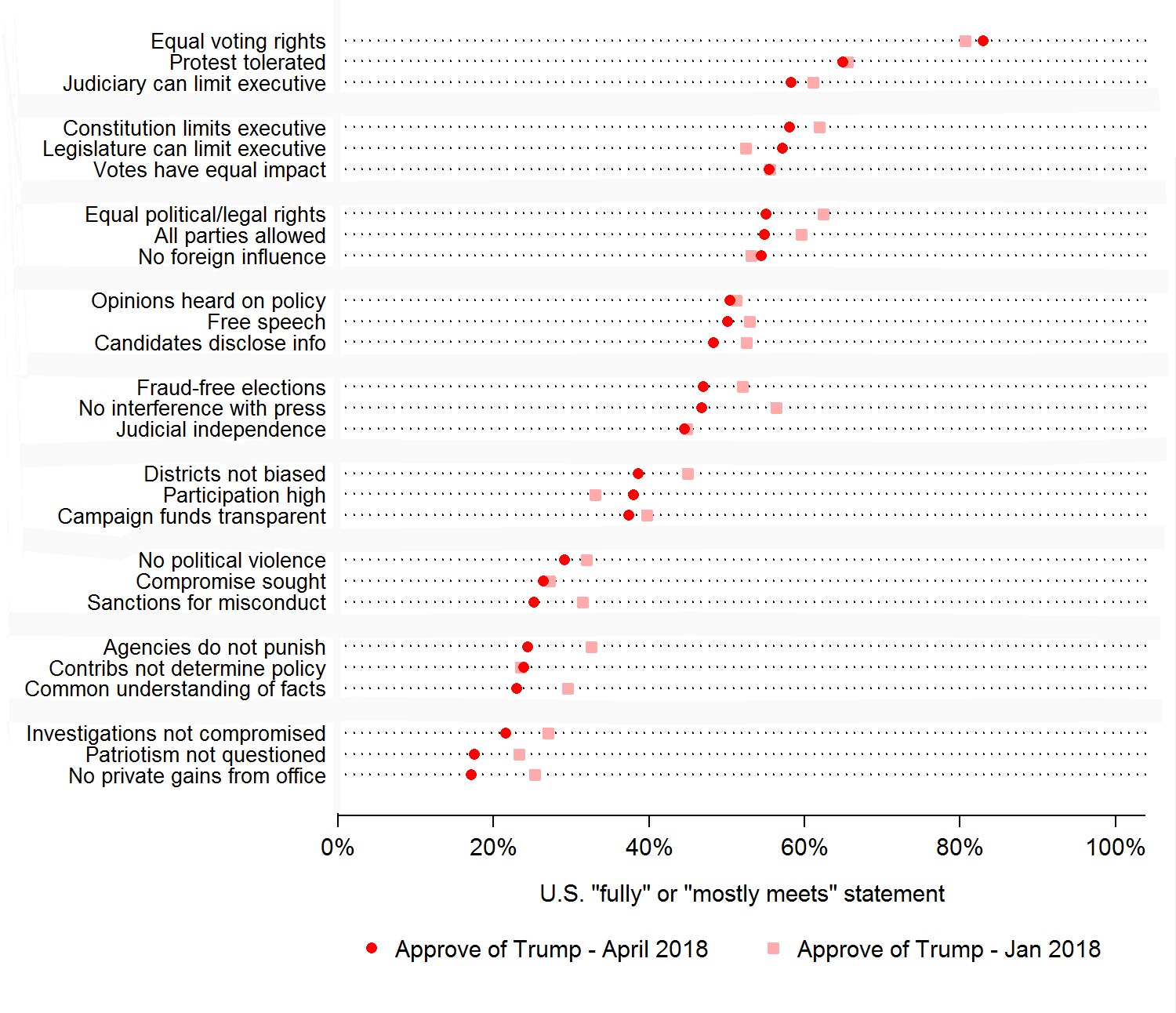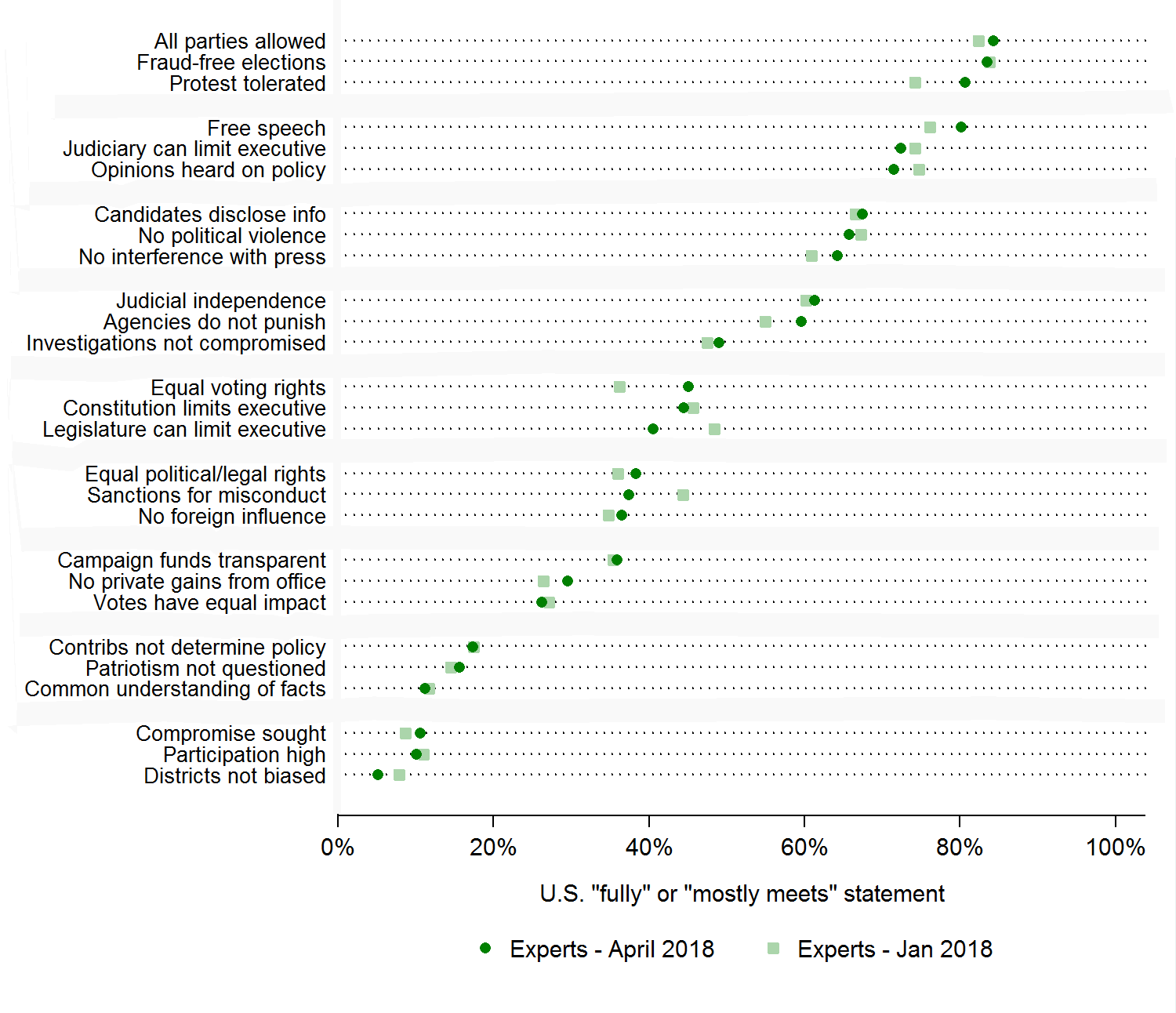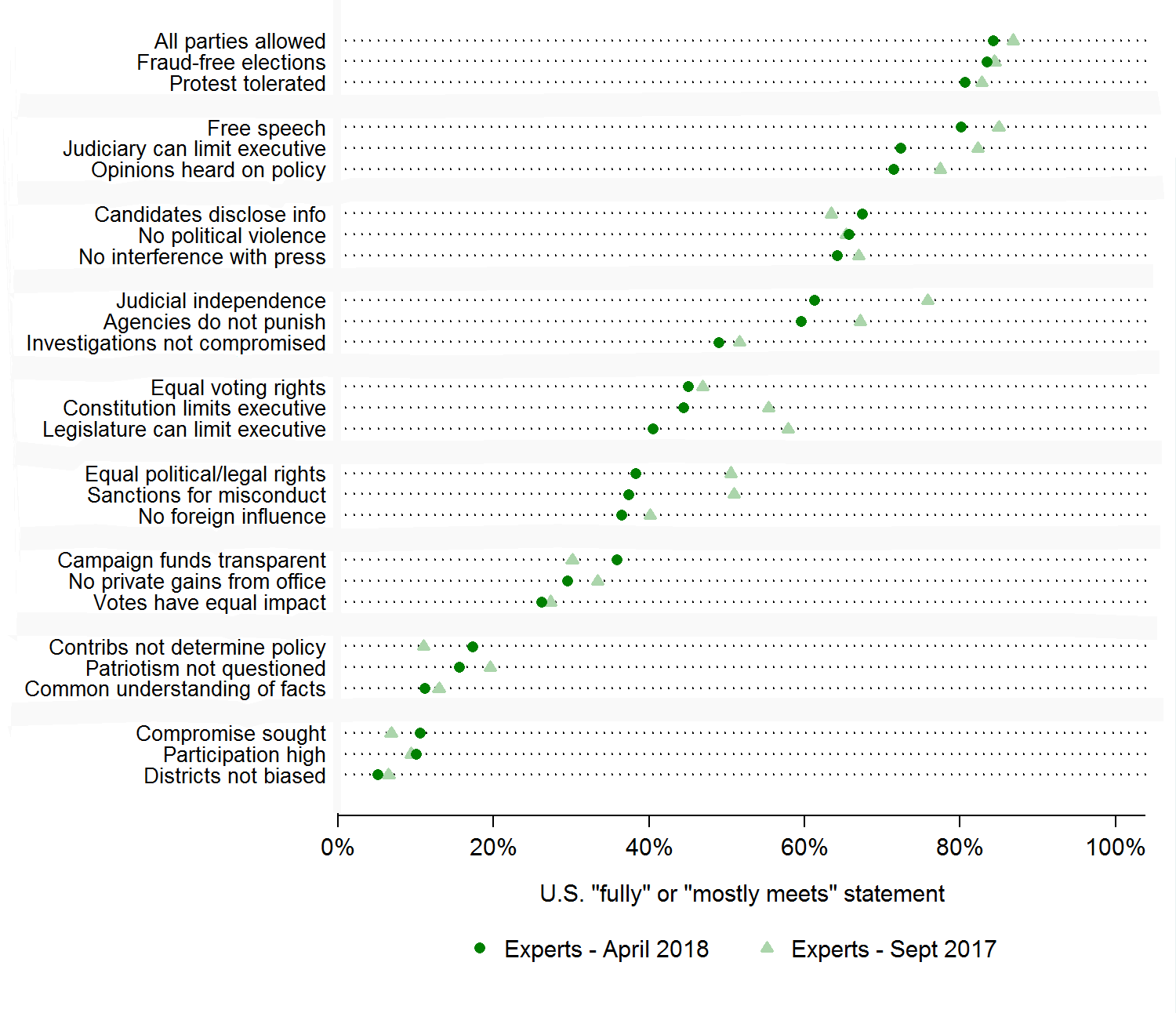Bright Line Watch Report on American Democracy
May 1, 2018
In April 2018, Bright Line Watch conducted its fifth expert survey, and its third public survey, on democracy in the United States. Between April 9 and 22, we surveyed an expert sample of 935 political science faculty at American universities and a nationally representative sample of 2,000 adults. Respondents in both surveys assessed the degree to which 27 democratic principles (listed in the Appendix to this report) are currently upheld in the United States.
We report two principal findings below. First, both public and expert respondents continue to rate U.S. democratic performance lower than in our September 2017 surveys in a number of areas. However, results indicate little change in perceptions of democratic performance relative to our most recent prior public and expert surveys, which were conducted in January 2018.
Our main metric of performance is the percentage of respondents who rated the United States as “fully” or “mostly” meeting a given democratic standard, as opposed to the percentage saying the United States only “partially meets” or “does not meet” it. We begin by reviewing results from our full sample of the public. Then we split the public sample according to the main political divide in contemporary American politics, dividing the public into those who approve of President Trump’s performance in office and those who disapprove. Finally, we compare results between our public respondents and our sample of experts.
Short-term stability, longer-term decline
Our April 2018 results show general stability in public perceptions of American democracy. The figure below shows the percentage of respondents who rated the U.S. as mostly or fully meeting each of our principles listed below in surveys conducted in January (light markers) and April (dark markers).
Change in Performance, January 2018 – April 2018: Public
None of the 27 democratic principles shows statistically discernible improvement, whereas we observe significant declines for three principles:
-
-
Political competition occurs without criticism of opponents’ loyalty or patriotism (21% in January, 14% in April). Evaluations for this norm, already low, declined both among those who approve of President Trump (from 23% to 18%) and those who disapprove (19% to 11%).
-
Government agencies are not used to monitor, attack, or punish political opponents (33% in January, 29% in April). Evaluations among Trump opponents changed little (34% to 32%), but we see a marked decline among Trump supporters (33% to 24%). The low results for both Trump supporters and Trump opponents suggest that the two groups might have different views about which agencies are politicized and about who is being punished.
-
The geographic boundaries of electoral districts do not systematically advantage any particular political party (29% in January, 25% in April). Evaluations of this principle declined for both Trump approvers (45% to 39%) and disapprovers (19% to 14%). Court cases targeting gerrymandering by both parties were prominent in the news during the first quarter of 2018, likely raising the salience of this issue for citizens on both sides of the partisan divide.
-
Of course, measurable declines on three of our principles also means that we observed stability from January to April on 24 others. As the time series of Bright Line Watch surveys grows, however, we can provide a longer view of public attitudes, which in turn reveals a more pessimistic picture. The figure below shows changes in public opinion stretching back to our first public survey, in September 2017. This is still only a seven month period, but enough to reveal declines across a much broader range of principles.
Change in Performance, September 2017 – April 2018: Public
In half a year, we detect statistically significant declines in 23 of our 27 democratic standards. The largest declines were for the following principles:
-
-
Government does not interfere with journalists or news organizations, where public belief that this standard is mostly or fully met dropped from 55% to 39%;
-
The elected branches respect judicial independence, which dropped from 56% to 42%; and
-
Agencies do not punish, mentioned above, which fell from 42% to 29%.
-
Importantly, diminished public evaluations of democratic performance are shared by both those who approve and those who disapprove of President Trump. Among the president’s supporters, from September 2017 to April 2018 we observed an average drop of 9 percentage points; among Trump opponents, we observed an average drop of 7 percentage points.
Performance gaps among the public
Drops in evaluations across numerous democratic standards sound ominous, but are these principles all equally important? To explain how we might distinguish between democratic norms, we provide an illustration in the figure below, which plots hypothetical democratic principles in two dimensions. Importance is represented on the horizontal axis and performance is represented on the vertical axis. At the upper right, we have a principle — say, freedom to protest peacefully — that is important and is being upheld. At lower left, we have another principle — say, deference to authority — that is rated as less important but on which U.S. democracy is seen as performing poorly. Such a performance evaluation might be unfortunate but not catastrophic if the principle is not regarded as important. By contrast, it would be highly problematic if a principle were violated that is widely regarded as essential to democracy — our hypothetical case at the bottom right of the figure.
A central question for our organization is whether violating such a principle would trigger a consensual defense of American democracy. Would leading political leaders act against their immediate partisan interests to protect a higher ideal? And if there are principles that approach this threshold, what are they?
The next figure shifts from the abstract back to the concrete, plotting the public’s assessments of how important each of our 27 principles is against current evaluations of performance. We measured public assessments of importance in our September 2017 survey. Respondents were asked to assess whether each of our 27 principles were “essential,” “important,” “beneficial but not required,” or “not relevant” for whether a country is democratic. A full report on that survey is here. Responses for the general importance of principles are dramatically more stable over time than assessments of importance, so we rely on our measures of importance across longer time periods and seek to measure performance quarterly.
Importance vs Performance: Public
Juxtaposing importance and performance, we can identify areas in which American democracy is meeting, and failing to meet, public expectations. The relationship between importance and performance is generally positive — the public tends to rate American democracy higher on its most valued principles. The exceptions, found in the lower-right quadrant where high importance is associated with low fulfillment, loom largest as potential “bright lines” for democracy.
We emphasize the importance of caution in interpreting this figure. There is no settled method, much less a mathematical formula, for defining what constitutes a dangerous gap between importance and performance. There will always be some principle that is closest to the lower right corner of the graph. Still, three principles stand out for their combination of high importance and low performance. All are related to the accountability of public officials:
-
Law enforcement investigations of public officials or their associates are free from political influence or interference (item #5 in the graph)
-
Government officials are legally sanctioned for misconduct (item #6)
-
Government officials do not use public office for private gain (item #13)
We think this point is worth underscoring. Our 27 items span a range of democratic values, including equality of citizens, the fairness and inclusiveness of democratic procedures, the protection of individual rights and liberties, and the civility with which our politicians conduct themselves. Citizens hold many ideals in high regard, but when asked to identify where our public aspirations and democratic performance are most out of sync, the consensus is strongest for the accountability of public officials.
Public polarization
So far, we have mostly focused on aggregate public opinion, only occasionally noting the differences between President Trump’s supporters and his opponents. We turn our attention now to that divide, though we wish to begin by noting an important element of consensus. The following figure, drawn from our September 2017 survey, shows ratings of importance by Trump supporters and Trump opponents across the 27 democratic principles. Ratings of importance are highly correlated (at .89), confirming that the two groups largely agree about the relative importance of our democratic principles.
Importance by Trump Approval
Consensus drops substantially, however, on whether these principles are being fulfilled. Although the assessments are still correlated (at .71), we see gaps of more than 15 percentage points between Trump supporters and Trump opponents on 8 of our 27 statements.
Performance by Trump Approval
As a measure of polarization, we rely on the difference between the percentage of Trump supporters and opponents who rate the United States as fully or mostly meeting each of our 27 standards. By this metric, polarization in perceived democratic performance is most pronounced around two main themes. The first is basic fairness and equality, particularly as related to elections:
-
All adult citizens have equal opportunity to vote (Trump supporter/opponent difference is 37%)
-
Elections are free from foreign influence (difference=33%)
-
The geographic boundaries of electoral districts do not systematically advantage any particular political party (difference=25%)
-
All adult citizens enjoy the same legal and political rights (difference=24%)
-
All votes have equal impact on election outcomes (difference=21%)
The next set of principles for which the gap in perceived democratic performance is high between Trump supporters and opponents concern institutional checks and balances:
-
The legislature is able to effectively limit executive power (difference=24%)
-
Executive authority cannot be expanded beyond constitutional limits (difference=20%)
-
The judiciary is able to effectively limit executive power (difference=16%)
These are the areas where Americans on either side of the partisan divide observe the same conditions and events and arrive at starkly different assessments of democratic performance.
Comparing expert and public evaluations
As with the public, we observe only limited changes in performance evaluations among our experts between our two most recent surveys, but diminished assessments across a wider range of principles over the longer period back to September 2017 (details are in the Appendix). From January to April of this year, the experts we surveyed report declines of eight percentage points on whether the legislature can effectively limit executive authority and seven percentage points on whether government officials are legally sanctioned for misconduct. Over that same period, by contrast, expert evaluations improved on whether citizens have equal voting rights (+9%), whether the right to peaceful protest is guaranteed (+6%), and on whether government agencies are used to punish political opponents (+5%). On the rest of our 27 items, there was no statistically discernible movement in expert evaluations. On the whole, then, expert assessments did not rise or fall systematically in the early months of 2018. Reaching back to September 2017, however, we see declines in expert evaluations on the following items (no corresponding improvements are observed):
-
The legislature is able to effectively limit executive power (58% to 40%
-
The elected branches respect judicial independence (76% to 61%)
-
Government officials are legally sanctioned for misconduct (51% to 37%)
-
All adult citizens enjoy the same legal and political rights (51% to 38%)
-
Executive authority cannot be expanded beyond constitutional limits (55% to 44%)
-
The judiciary is able to effectively limit executive power (82% to 72%)
-
Government agencies are not used to monitor, attack, or punish political opponents (67% to 60%)
As with the public, then, expert evaluations of performance show a general decline across the period since Bright Line Watch began conducting its surveys.
There is an important difference, however, between expert opinion and broader public opinion that warrants attention. The figure below plots the importance assessments versus performance assessments for each of our 27 items.
Importance vs Performance: Experts
As with the public, experts rated performance higher on the principles they value the most overall. Yet among the experts, the set of principles for which performance most lags importance differs from those identified by the public. For the public, the biggest “democratic disappointments” concern the accountability of government officials. The experts share disappointment on accountability (see item #12 in the graph, which concerns sanctions for misconduct), but are more deeply troubled about issues of fairness and equality:
-
All adult citizens enjoy the same legal and political rights (item #3)
-
All votes have equal impact on election outcomes (item #18)
-
The geographic boundaries of electoral districts do not systematically advantage any particular political party (item #20)
American democracy in the spring of 2018
The latest Bright Line Watch surveys show substantial stability from January to April of this year in evaluations of democratic performance. Among both our the public and expert samples, we see declines on a handful of the 27 democratic principles on which we measure the performance of U.S. democracy, scarce evidence of improvement, and no substantial movement on most items. However, we still find perceptions of degrading performance since September 2017 across a range of principles. The value of our instrument, we believe, increases with our ability to map perceived democratic performance across longer periods, allowing us to identify long-term trends. So far, the pattern is not encouraging.
We can also validate our results by comparing them to work by other scholars and organizations. A recent report from the Pew Research Center surveyed over 6,000 American adults between January and March 2018, using an instrument that mirrored our own in comparing assessments of importance and performance on numerous democratic principles. Pew’s results are consistent with ours, showing that some essential principles (for example, protection of the right to peaceful protest) are widely regarded as well protected whereas others reveal wide gaps between public evaluations of importance and performance (for example, equal rights and the fairness of congressional districts). Pew also confirms the wide partisan gulf in performance assessments on items related to equality and fairness, particularly with regard to elections.
Finally, we conclude with an observation about the prospects for a bright line that citizens will defend. The gap between ideals and practice among the public is greatest on basic accountability and punishment for malfeasance by government officials. Elites share these concerns to a significant extent, suggesting a possible area of convergence, but the public consensus that exists on the principle of accountability for government officials could fracture in practice. What kind of investigation counts as impartial? Which officials should rightly be sanctioned? Our surveys ask about general principles, but it remains to be seen if the public’s commitments to those principles will crumble if they are confronted with specific transgressions of democratic ideals.
Invitation for submission of questions for future BLW surveys
Bright Line Watch welcomes proposals for questions to be included in our surveys from students, other scholars, civil society organizations, or interested citizens. Guidelines on designing questions and proposing them for consideration are here.
Appendix: Survey method and data
Bright Line Watch surveys on the state of America’s democracy, April 2018
From April 9–22, 2018, Bright Line Watch conducted its fifth survey on the state of democracy in the United States. We conducted previous surveys in February (Wave 1), May (Wave 2), and September (Wave 3) of 2017, and in January of 2018 (Wave 4). Wave 1 and Wave 2 targeted expert respondents only. Waves 3–5 have paired the expert survey with one drawing on a representative public sample.
-
Expert: On April 9, we sent email invitations to 9,326 political science faculty at universities in the United States. By April 22, after two reminder emails, we had complete responses from 935 (a response rate of 10%).
-
Public: YouGov fielded the public survey from April 9–16, producing 2,000 complete responses.
Participants in each Wave 5 survey responded to a battery of questions about democratic performance in the United States. The data from both the expert and public surveys are available here. All analyses of the public data from YouGov incorporate survey weights.
The foundation of Bright Line Watch’s surveys is a list of 27 statements expressing a range of democratic principles. Democracy is a multidimensional concept. Our goal is to provide a detailed set of measures of democratic values and of the quality of American democracy. We are also interested in the resilience of democracy and the nature of potential threats it faces. Based on the experiences of other countries that have experienced democratic setbacks, we recognize that democratic erosion is not necessarily an across-the-board phenomenon. Some facets of democracy may be undermined first while others remain intact, at least initially. The range of principles that we measure allows us to focus attention on variation in specific institutions and practices that, in combination, shape the overall performance of our democracy.
Bright Line Watch’s Wave 1 survey included 19 statements of democratic principles. Based on feedback from respondents and consultation with colleagues, we expanded that list to 29 statements in Wave 2. We then reduced that set to what we intend to be a stable set of 27 statements for the Wave 3 through Wave 5 surveys. 17 of those 27 statements were included in Wave 1, and all 27 were included in Wave 2.
The full set of statements is presented below and grouped thematically for clarity. In the surveys, the principles were not categorized or labeled. Each respondent was shown a randomly selected subset of nine statements and asked to first rate the importance of those statements and then rate the performance of the United States on those dimensions.
27 statements of democratic principles
Elections
-
Elections are conducted, ballots counted, and winners determined without pervasive fraud or manipulation
-
Citizens have access to information about candidates that is relevant to how they would govern
-
The geographic boundaries of electoral districts do not systematically advantage any particular political party
-
Information about the sources of campaign funding is available to the public
-
Public policy is not determined by large campaign contributions
-
Elections are free from foreign influence
Voting
-
All adult citizens have equal opportunity to vote
-
All votes have equal impact on election outcomes
-
Voter participation in elections is generally high
Rights
-
All adult citizens enjoy the same legal and political rights
-
Parties and candidates are not barred due to their political beliefs and ideologies
-
Government protects individuals’ right to engage in unpopular speech or expression
-
Government protects individuals’ right to engage in peaceful protest
-
Citizens can make their opinions heard in open debate about policies that are under consideration
Protections
-
Government does not interfere with journalists or news organizations
-
Government effectively prevents private actors from engaging in politically-motivated violence or intimidation
-
Government agencies are not used to monitor, attack, or punish political opponents
Accountability
-
Government officials are legally sanctioned for misconduct
-
Government officials do not use public office for private gain
-
Law enforcement investigations of public officials or their associates are free from political influence or interference
Institutions
-
Executive authority cannot be expanded beyond constitutional limits
-
The legislature is able to effectively limit executive power
-
The judiciary is able to effectively limit executive power
-
The elected branches respect judicial independence
Discourse
-
Even when there are disagreements about ideology or policy, political leaders generally share a common understanding of relevant facts
-
Elected officials seek compromise with political opponents
-
Political competition occurs without criticism of opponents’ loyalty or patriotism
The Wave 5 survey consisted of two main parts. In the first, each respondent was asked, “How well do the following statements describe the United States as of today?” Each respondent was then presented with 14 statements of principle, randomly drawn from the set above, and offered the following response options:
-
The U.S. does not meet this standard.
-
The U.S. partly meets this standard.
-
The U.S. mostly meets this standard.
-
The U.S. fully meets this standard.
-
Not sure.
The order in which statements were presented in each battery was randomized for each respondent so there should be no priming or ordering effects in how they were assessed.
After completing the battery on U.S. performance, we asked respondents to rate the overall quality of democracy in the United States today on a scale from 0 to 100, where 0 is least democratic and 100 is most democratic.
Additional figures
Change in performance, January — April 2018: Trump disapprovers
Change in performance, January — April 2018: Trump approvers
Change in performance, January — April 2018: Expert sample
Change in performance, September 2017 – April 2018: Expert sample

